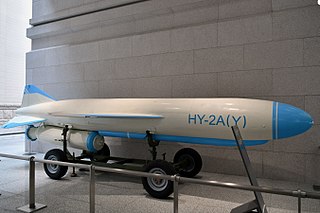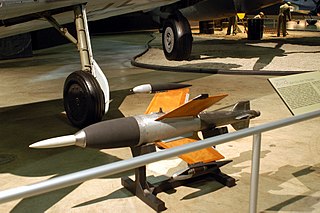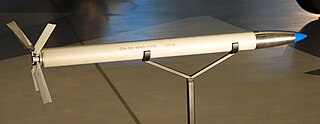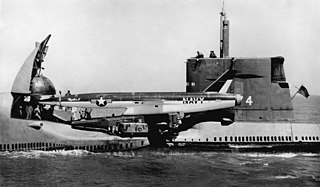The SM-65 Atlas was the first operational intercontinental ballistic missile (ICBM) developed by the United States and the first member of the Atlas rocket family. It was built for the U.S. Air Force by the Convair Division of General Dynamics at an assembly plant located in Kearny Mesa, San Diego. Atlas became operational in October 1959, but was soon made obsolete as an ICBM by new development, and was retired from this role by 1965.

The Army Ballistic Missile Agency (ABMA) was formed to develop the U.S. Army's first large ballistic missile. The agency was established at Redstone Arsenal on 1 February 1956, and commanded by Major General John B. Medaris with Wernher von Braun as technical director.

The Shang You or SY-series, and the Hai Ying or HY-series were early Chinese anti-ship cruise missiles. They were derived from the Soviet P-15 Termit missile.

Meteor is an active radar guided beyond-visual-range air-to-air missile (BVRAAM) developed by MBDA. Meteor offers a multi-shot capability, and has the ability to engage highly maneuverable targets, such as jets, and small targets such as UAVs and cruise missiles in a heavy electronic countermeasures (ECM) environment with a range in excess of 100 kilometres (54 nmi). A solid-fueled ramjet motor allows the missile to cruise at a speed of over Mach 4 and provides the missile with thrust and mid-course acceleration to target intercept. A two-way datalink enables the launch aircraft to provide mid-course target updates or retargeting if required, including data from off-board third parties. The datalink is capable of transmitting missile information such as functional and kinematic status, information about multiple targets, and notification of target acquisition by the seeker.

The Ruhrstahl Ru 344 X-4 or Ruhrstahl-Kramer RK 344 was a wire-guided air-to-air missile designed by Germany during World War II. The X-4 did not see operational service and thus was not proven in combat but inspired considerable post-war work around the world, and was the basis for the development of several ground-launched anti-tank missiles, including the Malkara.

The Dassault Étendard IV is a transonic carrier-borne strike fighter aircraft developed and manufactured by French aerospace company Dassault Aviation. It is the first indigenously designed carrier-capable jet aircraft to be produced in France.

The PGM-19 Jupiter was the first nuclear armed, medium-range ballistic missile (MRBM) of the United States Air Force (USAF). It was a liquid-propellant rocket using RP-1 fuel and LOX oxidizer, with a single Rocketdyne LR79-NA rocket engine producing 667 kilonewtons (150,000 lbf) of thrust. It was armed with the 1.44 megatons of TNT (6.0 PJ) W49 nuclear warhead. The prime contractor was the Chrysler Corporation.

The Dassault Mirage 2000N is a variant of the Mirage 2000 designed for nuclear strike. It formed the core of the French air-based strategic nuclear deterrent. The Mirage 2000D is its conventional attack counterpart.

The Mk 4 Folding-Fin Aerial Rocket (FFAR), also known as "Mighty Mouse", was an unguided rocket used by United States military aircraft. It was 2.75 inches (70 mm) in diameter. Designed as an air-to-air weapon for interceptor aircraft to shoot down enemy bombers, it primarily saw service as an air-to-surface weapon. The FFAR has been developed into the modern Hydra 70 series, which is still in service.

Astra is an Indian all weather beyond-visual-range active radar homing air-to-air missile, developed by the Defence Research and Development Organisation. It is the first air-to-air missile developed by India. Astra is designed to be capable of engaging targets at varying range and altitudes allowing for engagement of both short-range targets at a distance of 10 km (6.2 mi) and long-range targets up to a distance of 110 km (68 mi). Astra has been integrated with Indian Air Force's Sukhoi Su-30MKI and will be integrated with Dassault Mirage 2000, HAL Tejas and Mikoyan MiG-29 in the future. Limited series production of Astra missiles began in 2017.

Red Dean, a rainbow code name, was a large air-to-air missile developed for the Royal Air Force during the 1950s. Originally planned to use an active radar seeker to offer all-aspect performance and true fire-and-forget engagements, the valve-based electronics demanded a missile of prodigious size.

The Zvezda Kh-66 and Kh-23 Grom are a family of early Soviet tactical air-to-surface missiles with a range of 10 km. They were intended for use against small ground or naval targets. The Kh-66 was effectively a heavy-warhead, beam-riding version of the K-8 air-to-air missile rushed into service in Vietnam in 1968. The Kh-23 was an improved Kh-66 with command-guidance, similar to the AGM-12 Bullpup.

The GAM-63 RASCAL was a supersonic air-to-surface missile that was developed by the Bell Aircraft Company. The RASCAL was the United States Air Force's first nuclear armed standoff missile. The RASCAL was initially designated the ASM-A-2, then re-designated the B-63 in 1951 and finally re-designated the GAM-63 in 1955. The name RASCAL was the acronym for RAdar SCAnning Link, the missile's guidance system. The RASCAL project was cancelled in September 1958.

The AGM-176 Griffin is a lightweight, precision-guided munition developed by Raytheon. It can be launched from the ground or air as a rocket-powered missile or dropped from the air as a guided bomb. It carries a relatively small warhead, and was designed to be a precision low-collateral damage weapon for irregular warfare. It has been used in combat by the United States military during the War in Afghanistan.

The SNCASO SO.9000 Trident was a French mixed-power interceptor aircraft built by aircraft manufacturer SNCASO during the 1950s. As part of a wider effort to re-build French military power during the late 1940s and to furnish France with advanced, new domestically produced designs, a request for a supersonic-capable point-defence interceptor aircraft to equip the French Air Force was issued to SNCASO. In response, the firm designed the mixed-propulsion Trident, powered by a single SEPR rocket engine, which was augmented by wingtip-mounted turbojet engines, and the Air Force ordered two prototypes.

The SNCASE Grognard was designed as a single-seat, low-level ground-attack aircraft. Although in development in the 1950s for the French Armée de l'Air, the program was cancelled in favor of the Sud-Ouest Vautour II.

The SSM-N-9 Regulus II cruise missile is a supersonic guided missile armed with a nuclear warhead, intended for launching from surface ships and submarines of the U.S. Navy (USN).

The Fairchild BQ-3, also known as the Model 79, was an early expendable unmanned aerial vehicle – referred to at the time as an "assault drone" – developed by Fairchild Aircraft from the company's AT-21 Gunner advanced trainer during the Second World War for use by the United States Army Air Forces. Two examples of the type were built and flight-tested, but the progress of guided missiles rendered the assault drone quickly obsolete, and the type was not produced.

The Bombardment Aircraft Rocket, also known as BOAR, the Bureau of Ordnance Aircraft Rocket, and officially as the 30.5-Inch Rocket, Mark 1, Mod 0, was an unguided air-to-surface rocket developed by the United States Navy's Naval Ordnance Test Station during the 1950s. Intended to provide a standoff nuclear capability for carrier-based aircraft, the rocket entered operational service in 1956, remaining in service until 1963.

The AAM-N-4 Oriole was an early American air-to-air missile, developed by the Glenn L. Martin Company for the United States Navy. Designed for launch from carrier-based aircraft, the missile programme was cancelled before flight testing began, and the missiles produced were utilized as test vehicles.


















